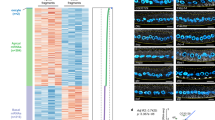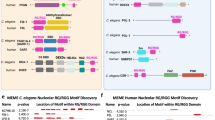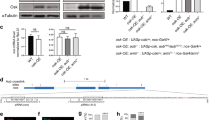Abstract
bicoid messenger RNA localizes to the anterior of the Drosophila egg, where it is translated to form a morphogen gradient of Bicoid protein that patterns the head and thorax of the embryo. Although bicoid was the first localized cytoplasmic determinant to be identified1,2,3,4, little is known about how the mRNA is coupled to the microtubule-dependent transport pathway that targets it to the anterior, and it has been proposed that the mRNA is recognized by a complex of many redundant proteins, each of which binds to the localization element in the 3′ untranslated region (UTR) with little or no specificity5. Indeed, the only known RNA-binding protein that co-localizes with bicoid mRNA is Staufen, which binds non-specifically to double-stranded RNA in vitro6,7. Here we show that mutants in all subunits of the ESCRT-II complex (VPS22, VPS25 and VPS36) abolish the final Staufen-dependent step in bicoid mRNA localization. ESCRT-II is a highly conserved component of the pathway that sorts ubiquitinated endosomal proteins into internal vesicles8,9, and functions as a tumour-suppressor by removing activated receptors from the cytoplasm10,11. However, the role of ESCRT-II in bicoid localization seems to be independent of endosomal sorting, because mutations in ESCRT-I and III components do not affect the targeting of bicoid mRNA. Instead, VPS36 functions by binding directly and specifically to stem-loop V of the bicoid 3′ UTR through its amino-terminal GLUE domain12, making it the first example of a sequence-specific RNA-binding protein that recognizes the bicoid localization signal. Furthermore, VPS36 localizes to the anterior of the oocyte in a bicoid-mRNA-dependent manner, and is required for the subsequent recruitment of Staufen to the bicoid complex. This function of ESCRT-II as an RNA-binding complex is conserved in vertebrates and may clarify some of its roles that are independent of endosomal sorting.
This is a preview of subscription content, access via your institution
Access options
Subscribe to this journal
Receive 51 print issues and online access
$199.00 per year
only $3.90 per issue
Buy this article
- Purchase on Springer Link
- Instant access to full article PDF
Prices may be subject to local taxes which are calculated during checkout




Similar content being viewed by others
References
Frohnhöfer, H. G. & Nüsslein-Volhard, C. Organization of anterior pattern in the Drosophila embryo by the maternal gene bicoid. Nature 324, 120–125 (1986)
Berleth, T. et al. The role of localization of bicoid RNA in organizing the anterior pattern of the Drosophila embryo. EMBO J. 7, 1749–1756 (1988)
Driever, W. & Nüsslein-Volhard, C. A gradient of Bicoid protein in Drosophila embryos. Cell 54, 83–93 (1988)
Driever, W. & Nüsslein-Volhard, C. The Bicoid protein determines position in the Drosophila embryo in a concentration-dependent manner. Cell 54, 95–104 (1988)
Arn, E. A., Cha, B. J., Theurkauf, W. E. & Macdonald, P. M. Recognition of a bicoid mRNA localization signal by a protein complex containing Swallow, Nod, and RNA binding proteins. Dev. Cell 4, 41–51 (2003)
St Johnston, D., Beuchle, D. & Nüsslein-Volhard, C. staufen, a gene required to localize maternal RNAs in the Drosophila egg. Cell 66, 51–63 (1991)
Ramos, A. et al. RNA recognition by a Staufen double-stranded RNA-binding domain. EMBO J. 19, 997–1009 (2000)
Babst, M. A protein's final ESCRT. Traffic 6, 2–9 (2005)
Babst, M., Katzmann, D. J., Snyder, W. B., Wendland, B. & Emr, S. D. Endosome-associated complex, ESCRT-II, recruits transport machinery for protein sorting at the multivesicular body. Dev. Cell 3, 283–289 (2002)
Vaccari, T. & Bilder, D. The Drosophila tumor suppressor vps25 prevents nonautonomous overproliferation by regulating Notch trafficking. Dev. Cell 9, 687–698 (2005)
Thompson, B. J. et al. Tumor suppressor properties of the ESCRT-II complex component Vps25 in Drosophila. Dev. Cell 9, 711–720 (2005)
Teo, H. et al. ESCRT-I core and ESCRT-II GLUE domain structures reveal role for GLUE in linking to ESCRT-I and membranes. Cell 125, 99–111 (2006)
Frohnhöfer, H. G. & Nüsslein-Volhard, C. Maternal genes required for the anterior localization of bicoid activity in the embryo of Drosophila. Genes Dev. 1, 880–890 (1987)
Macdonald, P. M., Luk, S. K. & Kilpatrick, M. Protein encoded by the exuperantia gene is concentrated at sites of bicoid mRNA accumulation in Drosophila nurse cells but not in oocytes or embryos. Genes Dev. 5, 2455–2466 (1991)
Wilhelm, J. E. et al. Isolation of a ribonucleoprotein complex involved in mRNA localization in Drosophila oocytes. J. Cell Biol. 148, 427–440 (2000)
Theurkauf, W. E. & Hazelrigg, T. I. In vivo analyses of cytoplasmic transport and cytoskeletal organization during Drosophila oogenesis: characterization of a multi-step anterior localization pathway. Development 125, 3655–3666 (1998)
Moon, W. & Hazelrigg, T. The Drosophila microtubule-associated protein Mini spindles is required for cytoplasmic microtubules in oogenesis. Curr. Biol. 14, 1957–1961 (2004)
Vogt, N., Koch, I., Schwarz, H., Schnorrer, F. & Nüsslein-Volhard, C. The γTuRC components Grip75 and Grip128 have an essential microtubule-anchoring function in the Drosophila germline. Development 133, 3963–3972 (2006)
Ferrandon, D., Elphick, L., Nüsslein-Volhard, C. & St Johnston, D. Staufen protein associates with the 3′UTR of bicoid mRNA to form particles that move in a microtubule-dependent manner. Cell 79, 1221–1232 (1994)
Weil, T. T., Forrest, K. M. & Gavis, E. R. Localization of bicoid mRNA in late oocytes is maintained by continual active transport. Dev. Cell 11, 251–262 (2006)
St Johnston, D., Driever, W., Berleth, T., Richstein, S. & Nüsslein-Volhard, C. Multiple steps in the localization of bicoid RNA to the anterior pole of the Drosophila oocyte. Development 107, (Suppl)13–19 (1989)
Macdonald, P. M., Kerr, K., Smith, J. L. & Leask, A. RNA regulatory element BLE1 directs the early steps of bicoid mRNA localization. Development 118, 1233–1243 (1993)
Micklem, D. R., Adams, J., Grunert, S. & St Johnston, D. Distinct roles of two conserved Staufen domains in oskar mRNA localization and translation. EMBO J. 19, 1366–1377 (2000)
Martin, S. G., Leclerc, V., Smith-Litière, K. & St Johnston, D. The identification of novel genes required for Drosophila anteroposterior axis formation in a germline clone screen using GFP-Staufen. Development 130, 4201–4215 (2003)
Teo, H., Perisic, O., Gonzalez, B. & Williams, R. L. ESCRT-II, an endosome-associated complex required for protein sorting: crystal structure and interactions with ESCRT-III and membranes. Dev. Cell 7, 559–569 (2004)
Moberg, K. H., Schelble, S., Burdick, S. K. & Hariharan, I. K. Mutations in erupted, the Drosophila ortholog of mammalian Tumor Susceptibility Gene 101, elicit non-cell-autonomous overgrowth. Dev. Cell 9, 699–710 (2005)
Kamura, T. et al. Cloning and characterization of ELL-associated proteins EAP45 and EAP20. A role for yeast EAP-like proteins in regulation of gene expression by glucose. J. Biol. Chem. 276, 16528–16533 (2001)
Schmidt, A. E., Miller, T., Schmidt, S. L., Shiekhattar, R. & Shilatifard, A. Cloning and characterization of the EAP30 subunit of the ELL complex that confers derepression of transcription by RNA polymerase II. J. Biol. Chem. 274, 21981–21985 (1999)
Jin, Y., Mancuso, J. J., Uzawa, S., Cronembold, D. & Cande, W. Z. The fission yeast homolog of the human transcription factor EAP30 blocks meiotic spindle pole body amplification. Dev. Cell 9, 63–73 (2005)
Putz, U., Skehel, P. & Kuhl, D. A tri-hybrid system for the analysis and detection of RNA–protein interactions. Nucleic Acids Res. 24, 4838–4840 (1996)
Acknowledgements
We are very grateful to R. Williams, O. Perisec and H. Teo for giving us the purified recombinant Xenopus laevis VPS36 GLUE domain, and for their helpful advice on ESCRT-II. We thank J. Oberdick and Z. Zhang for sharing their unpublished results on rat VPS36. This work was supported by a Wellcome Trust Principal Research Fellowship to D.St J. and by the Max-Planck-Gesellschaft (U.I.).
Author information
Authors and Affiliations
Corresponding author
Ethics declarations
Competing interests
GenBank accession numbers for the VPS36 genomic rescue construct and the Venus–VPS36 construct (see Supplementary Information) are EF152770 and EF152771, respectively. Reprints and permissions information is available at www.nature.com/reprints. The authors declare no competing financial interests.
Supplementary information
Supplementary Information
This file contains Supplementary Methods, Supplementary Figures S1-S2 and additional references. (PDF 1272 kb)
Rights and permissions
About this article
Cite this article
Irion, U., St Johnston, D. bicoid RNA localization requires specific binding of an endosomal sorting complex. Nature 445, 554–558 (2007). https://doi.org/10.1038/nature05503
Received:
Accepted:
Issue Date:
DOI: https://doi.org/10.1038/nature05503
This article is cited by
-
Pathogenic Extracellular Vesicle (EV) Signaling in Amyotrophic Lateral Sclerosis (ALS)
Neurotherapeutics (2022)
-
Modulating the bicoid gradient in space and time
Hereditas (2021)
-
The functional organization of axonal mRNA transport and translation
Nature Reviews Neuroscience (2021)
-
bicoid RNA localization requires the trans-Golgi network
Hereditas (2019)
-
ESCRT Proteins Control the Dendritic Morphology of Developing and Mature Hippocampal Neurons
Molecular Neurobiology (2019)
Comments
By submitting a comment you agree to abide by our Terms and Community Guidelines. If you find something abusive or that does not comply with our terms or guidelines please flag it as inappropriate.



